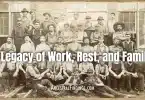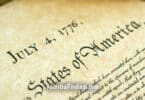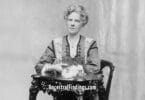Thanksgiving is one of our most cherished American holidays. Yet, its beginnings are murky. There is the traditional story of the Native Americans and the Pilgrims, but that is only a simplified version of what really happened, and has only a vague connection to the Thanksgiving we celebrate today. In fact, the real story of America’s Thanksgiving involves a lot of different players across four centuries. This is the story of Thanksgiving in America and how our ancestors celebrated it.
The colonists who came to America from Europe were used to celebrating various days of “thanksgiving” for good things that happened to them. These could be either feast of fasting days and were declared by the religious and civil authorities as needed. The first thanksgiving event to be recorded by Europeans in America was held by Spanish colonists in the late 1500s, long before the Pilgrims came here. English explorers to Virginia began having thanksgiving days in 1607, and the first permanent English settlement in America, Jamestown, had a thanksgiving in 1610. A group of 38 English colonists came to Virginia in 1619, a year before the Pilgrims, and their charter actually required them to celebrate a thanksgiving for safe arrival in America and to celebrate the date of their arrival annual thereafter. These celebrations were kept up annually for three years until troubles began with the local natives and the colonists abandoned the area in 1621.
The celebration that is most closely associated with the Thanksgiving we celebrate today was indeed a meal shared between Pilgrim colonists in New England and the local Native Americans. This was held over a three-day period in 1621, after the Pilgrims’ first successful harvest. The Natives, who provided food to the colonists to get them through their first winter here when their supplies ran low, were invited guests. Because so many Pilgrims died that first winter, more than half the number who came on the Mayflower the previous year, there were almost double the number of Natives present as there were Pilgrims. The exact date of the feast is not known but is estimated by historians to have taken place between September 21 and November 11, 1621.
The Puritans, who colonized the rest of New England a few years after the Pilgrims came, began celebrating their own thanksgiving in 1630 and celebrated it regularly, though not on any set schedule, until 1680. After that, it became an annual festival in Massachusetts. Connecticut and New York soon took up the tradition, as well. By the 1700s, the colonies were all celebrating their own Thanksgivings, but at different times of the year.
The first nationally proclaimed Thanksgiving in America, once it was liberated from Great Britain after the Revolutionary War, was declared by President George Washington on October 3, 1789. However, Thanksgiving was not designated an official federal holiday until 1863, when President Abraham Lincoln ordered it to be so and made it the last Thursday in November. This was during the Civil War, and Lincoln declared the holiday should be to give thanks…
“I do therefore invite my fellow citizens in every part of the United States, and also those who are at sea and those who are sojourning in foreign lands, to set apart and observe the last Thursday of November next, as a day of Thanksgiving and Praise to our beneficent Father who dwelleth in the Heavens.” ~ President Abraham Lincoln
“In every thing give thanks: for this is the will of God”, 1 Thessalonians 5:18.
After the Civil War, the reunited nation continued to celebrate the holiday as a national one.
There was some controversy in the 1930s when President Franklin Roosevelt tried to change the date of Thanksgiving to the next to last Thursday in November, rather than the last Thursday, as people had been used to celebrating. He thought it would stimulate the economy by encouraging a longer Christmas shopping season after the holiday. Not every state adopted the change, and there was a short period of time where there was a “Republican” Thanksgiving held on the traditional date, and a “Democratic” one held on Franklin’s preferred date. A compromise was eventually reached to celebrate Thanksgiving on the fourth Thursday of November, which is sometimes the last and sometimes the next to last, depending on the calendar that year. This is how we determine which day is Thanksgiving to this day.
As for holiday traditions, the meal we eat at Thanksgiving has always been based on the foods eaten at the famous meal between the Native Americans and the Pilgrims. It has been this way from the time George Washington declared the first national Thanksgiving. This means plenty of seasonal foods that are not readily available at other parts of the year. This is why the traditional American Thanksgiving meal is so recognizable, as it has changed little over the generations. It is also why we typically do not eat all of these Thanksgiving foods all at one meal at other times of the year. So, the Thanksgiving you celebrate today is virtually unchanged from the ones your ancestors celebrated nearly 250 years ago. It’s one thing that has really united Americans together and tied one generation to the other for most of our history as a nation.
“Thanks be to God for his inexpressible gift”, 2 Corinthians 9:15







